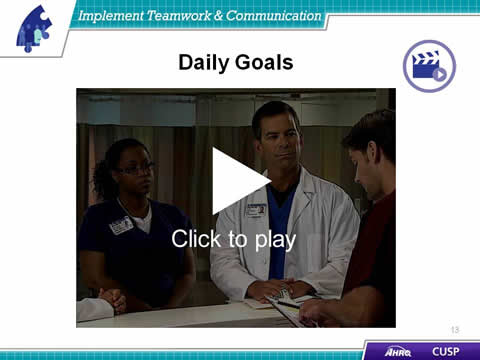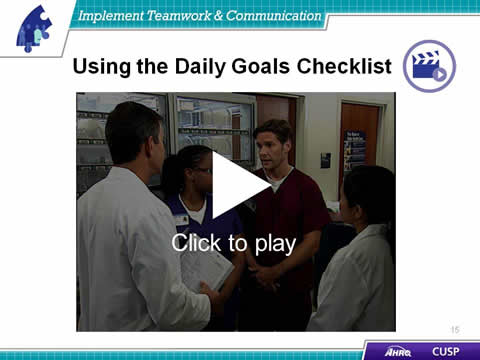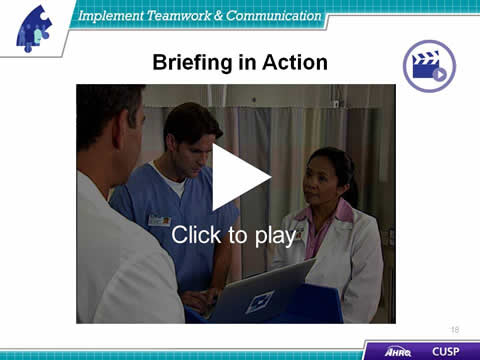Implement Teamwork and Communication
CUSP Toolkit
Contents
Slide 1. Cover Slide
Slide 2. Learning Objectives
Slide 3. Basic Components and Process of Communication2
Slide 4. Four Key Components of Effective Communication1
Slide 5. Elements That Affect Communication and Information Exchange3
Slide 6. Communication Breakdowns Cause Treatment Delays
Slide 7. Communication Breakdowns Cause Infection-Associated Events3
Slide 8. Exercise
Slide 9. Barriers to Team Effectiveness1
Slide 10. Positive Outcomes of Effective Teamwork on Health Care4
Slide 11. Shadowing
Slide 12. Daily Goals Checklist
Slide 13. Daily Goals
Slide 14. How to Use the Daily Goals Checklist
Slide 15. Using the Daily Goals Checklist
Slide 16. Selected TeamSTEPPS Tools1
Slide 17. Briefing1
Slide 18. Briefing in Action
Slide 19. Huddle1
Slide 20. Debriefing1
Slide 21. STEP1
Slide 22. I'M Safe1
Slide 23. Task Assistance1
Slide 24. Feedback1
Slide 25. Advocacy and Assertion1
Slide 26. Two-Challenge Rule1
Slide 27. DESC Script1
Slide 28. CUS1
Slide 29. Collaboration1
Slide 30. SBAR1
Slide 31. Call-Out1
Slide 32. Check-Back1
Slide 33. Handoff1
Slide 34. I PASS the BATON1
Slide 35. Situational Awareness1
Slide 36. Implement Teamwork and Communication: What the Team Needs to Do
Slide 37. Summary
Slide 38. Additional CUSP Tools
Slide 39. References
Note: Slide content is presented below each of the images.
Slide 1. Cover Slide
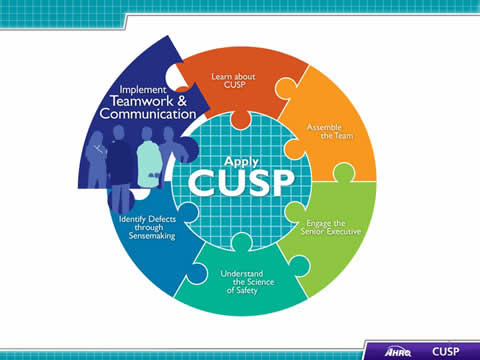
Image: CUSP Toolkit logo.
Slide 2. Learning Objectives
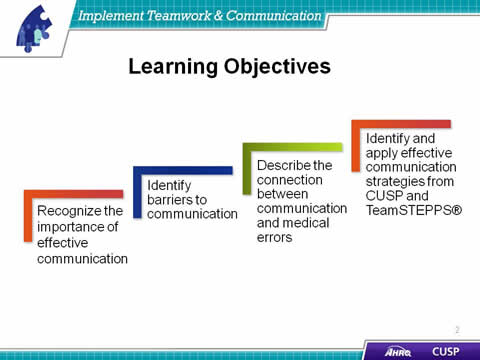
- Recognize the importance of effective communication.
- Identify barriers to communication.
- Describe the connection between communication and medical errors.
- Identify and apply effective communication strategies from CUSP and TeamSTEPPS®.
Slide 3. Basic Components and Process of Communication2
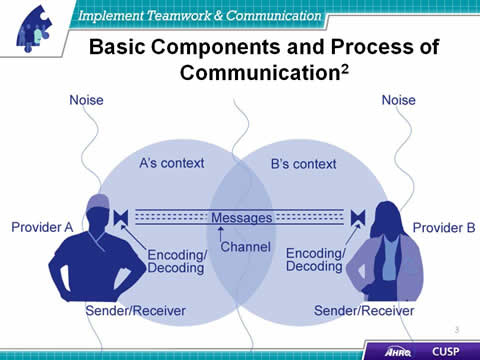
Provider A – Sender and Receiver.
- Noise.
- A’s Context.
- Encoding and Decoding.
Messages.
- Channel.
Provider B – Sender and Receiver.
- Noise.
- B’s Context.
- Encoding and Decoding.
Slide 4. Four Key Components of Effective Communication1
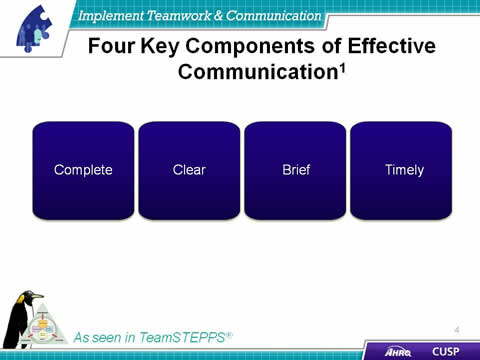
- Complete.
- Clear.
- Brief.
- Timely.
Slide 5. Elements That Affect Communication and Information Exchange
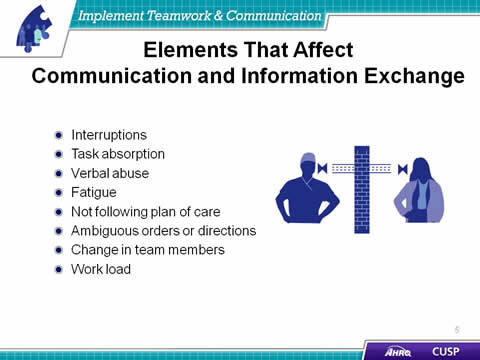
- Interruptions.
- Task absorption.
- Verbal abuse.
- Fatigue.
- Not following plan of care.
- Ambiguous orders or directions.
- Change in team members.
- Work load.
Slide 6. Communication Breakdowns Cause Treatment Delays3
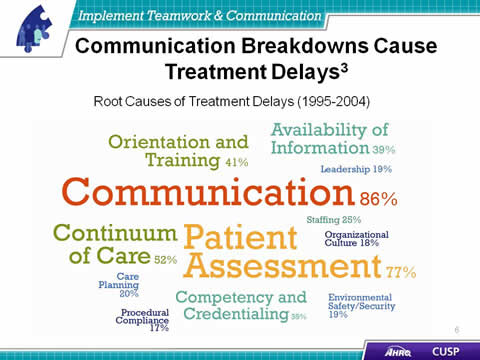
Root Causes of Treatment Delays (1995-2004)
The root causes of treatment delays are as follows:
Communication 86%
Patient Assessment 77%
Continuum of Care 52%
Orientation and Training 41%
Availability of Information 39%
Competency and Credentialing 35%
Staffing 25%
Care Planning 20%
Leadership 19%
Environmental Safety and Security 19%
Organizational Culture 18%
Procedural Compliance 17%
Slide 7. Communication Breakdowns Cause Infection-Associated Events3
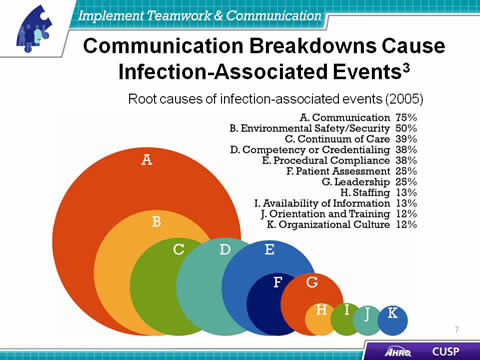
Root causes of infection-associated events (2005)
The root causes of infection-associated events are as follows:
Communication 75%
Environmental Safety/Security 50%
Continuum of Care 39%
Competency or Credentialing 38%
Procedural Compliance 38%
Patient Assessment 25%
Leadership 25%
Staffing 13%
Availability of Information 13%
Orientation and Training 12%
Organizational Culture 12%
Slide 8. Exercise
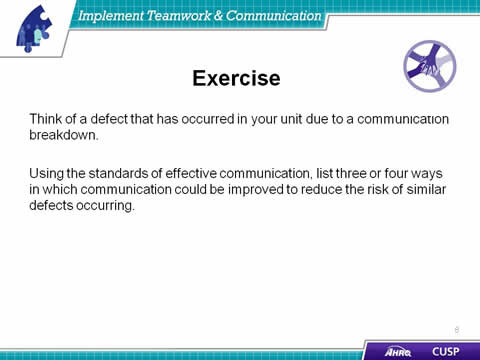
Think of a defect that has occurred in your unit due to a communication breakdown.
Using the standards of effective communication, list three to four ways in which communication could be improved to reduce the risk of similar defects occurring.
Slide 9. Barriers to Team Effectiveness1
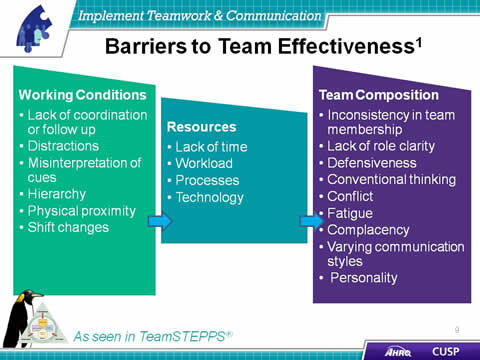
Working Conditions:
- Lack of coordination or followup.
- Distractions.
- Misinterpretation of cues.
- Hierarchy.
- Physical proximity.
- Shift changes.
Resources
- Lack of time.
- Workload.
- Processes.
- Technology.
Team Composition
- Inconsistency in team membership.
- Lack of role clarity.
- Defensiveness.
- Conventional thinking.
- Conflict.
- Fatigue.
- Complacency.
- Varying communication styles.
- Personality.
Slide 10. Positive Outcomes of Effective Teamwork on Health Care4
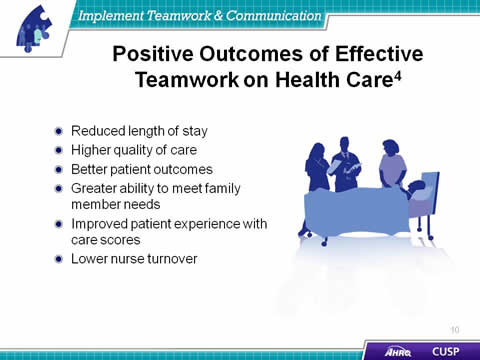
- Reduced length of stay.
- Higher quality of care.
- Better patient outcomes.
- Greater ability to meet family member needs.
- Improved patient experience with care scores.
- Lower nurse turnover.
Slide 11. Shadowing
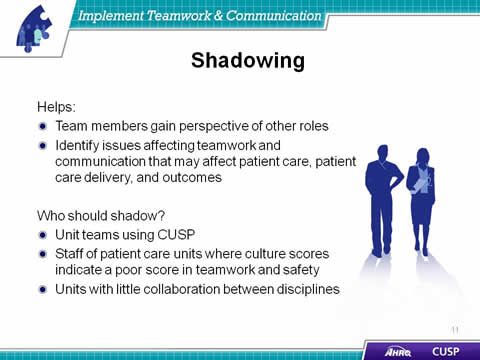
Helps:
- Team members gain perspective of other roles.
- Identify issues affecting teamwork and communication that may affect patient care, patient care delivery, and outcomes.
Who should shadow?
- Unit teams using CUSP.
- Staff of patient care units where culture scores indicate a poor score in teamwork and safety.
- Units with little collaboration between disciplines.
Slide 12. Daily Goals Checklist
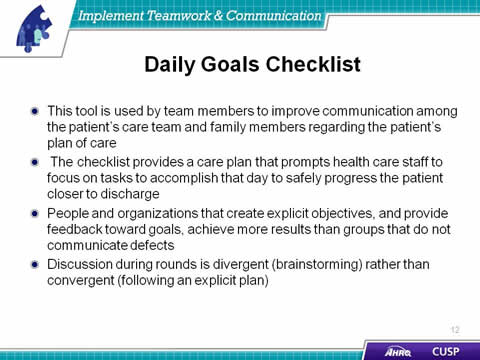
- This tool is used by team members to improve communication among the patient's care team and family members regarding the patient's plan of care.
- The checklist provides a care plan that prompts health care staff to focus on tasks to accomplish that day to safely progress the patient closer to discharge.
- People and organizations that create explicit objectives, and provide feedback toward goals, achieve more results than groups that do not communicate defects.
- Discussion during rounds is divergent (brainstorming) rather than convergent (following an explicit plan).
Slide 13. Daily Goals
(vignette still)
Click to play.
Slide 14. How to Use the Daily Goals Checklist
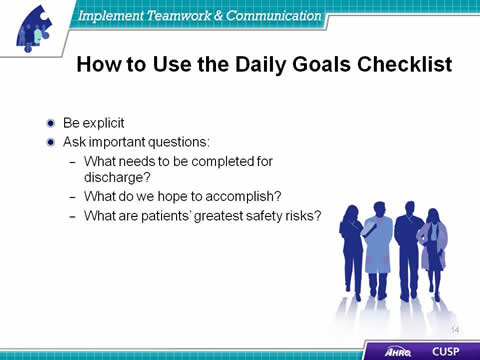
- Be explicit
- Ask important questions:
- What needs to be completed for discharge?
- What do we hope to accomplish?
- What are patients’ greatest safety risks?
Slide 15. Using the Daily Goals Checklist
(vignette still)
Click to play.
Slide 16. Selected TeamSTEPPS Tools1
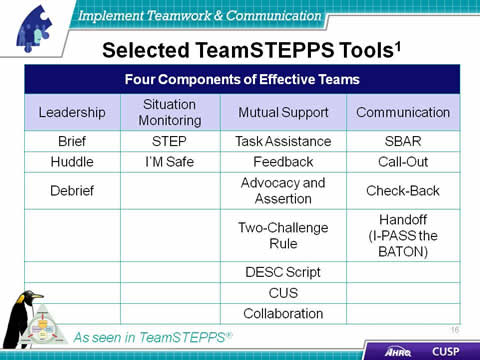
Four Components of Effective Teams
Leadership:
- Brief.
- Huddle.
- Debrief.
Situation Monitoring:
- STEP.
- I’M Safe.
Mutual Support:
- Task Assistance.
- Feedback.
- Advocacy and Assertion.
- Two-Challenge Rule.
- DESC Script.
- CUS.
- Collaboration.
Communication:
- SBAR.
- Call-Out.
- Check-Back.
- Handoff (I-PASS the BATON).
Slide 17. Briefing1
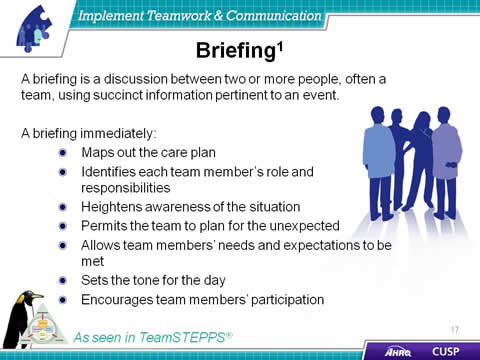
A briefing is a discussion between two or more people, often a team, using succinct information pertinent to an event.
A briefing immediately:
- Maps out the care plan.
- Identifies each team member’s role and responsibilities.
- Heightens awareness of the situation.
- Permits the team to plan for the unexpected.
- Allows team members’ needs and expectations to be met.
- Sets the tone for the day.
Slide 18. Briefing in Action
(vignette still)
Click to play.
Slide 19. Huddle1
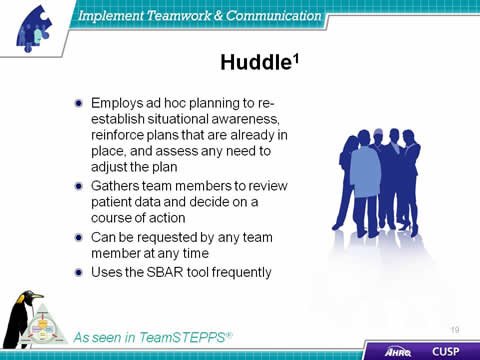
- Employs ad hoc planning to re-establish situational awareness, reinforce plans that are already in place, and assess any need to adjust the plan.
- Gathers team members to review patient data and decide on a course of action.
- Can be requested by any team member at any time.
- Uses the SBAR tool frequently.
Slide 20. Debriefing1
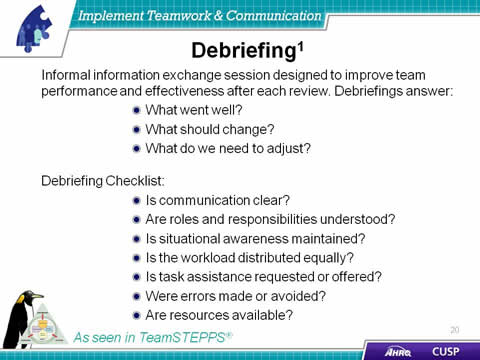
Informal information exchange session designed to improve team performance and effectiveness after each review. Debriefings answer:
- What went well?
- What should change?
- What do we need to adjust?
Debriefing Checklist:
- Is communication clear?
- Are roles and responsibilities understood?
- Is situational awareness maintained?
- Is the workload distributed equally?
- Is task assistance requested or offered?
- Were errors made or avoided?
- Are resources available?
Slide 21. STEP1
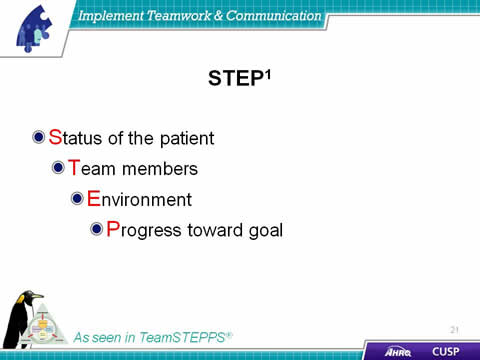
Status of the patient
Team members
Environment
Progress toward goal
Slide 22. I'M Safe1
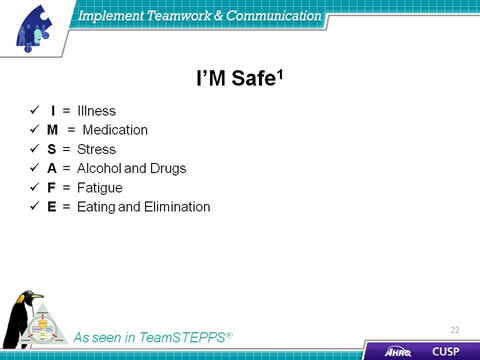
I = Illness
M = Medication
S = Stress
A = Alcohol and Drugs
F = Fatigue
E = Eating and Elimination
Slide 23. Task Assistance1
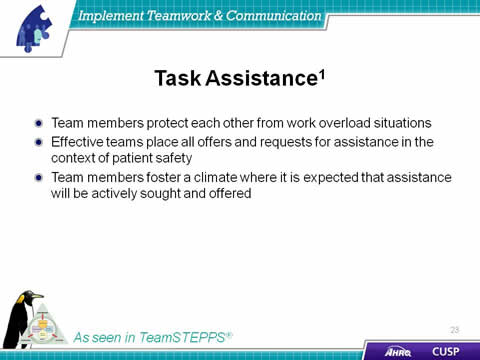
- Team members protect each other from work overload situations.
- Effective teams place all offers and requests for assistance in the context of patient safety.
- Team members foster a climate where it is expected that assistance will be actively sought and offered.
Slide 24. Feedback1
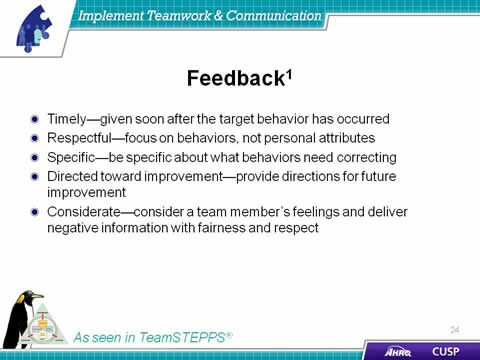
- Timely—given soon after the target behavior has occurred.
- Respectful—focus on behaviors, not personal attributes.
- Specific—be specific about what behaviors need correcting.
- Directed toward improvement—provide directions for future improvement.
- Considerate—consider a team member’s feelings and deliver negative information with fairness and respect.
Slide 25. Advocacy and Assertion1
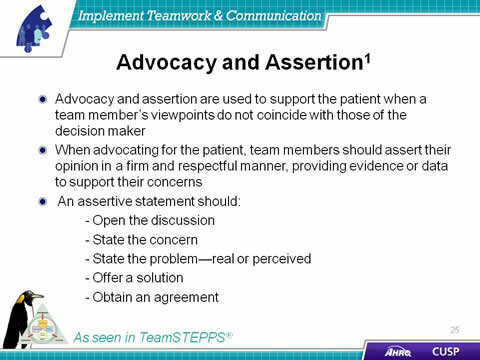
- Advocacy and assertion are used to support the patient when a team member’s viewpoints do not coincide with those of the decision maker.
- When advocating for the patient, team members should assert their opinion in a firm and respectful manner, providing evidence or data to support their concerns.
- An assertive statement should:
- Open the discussion.
- State the concern.
- State the problem—real or perceived.
- Offer a solution.
- Obtain an agreement.
Slide 26. Two-Challenge Rule1
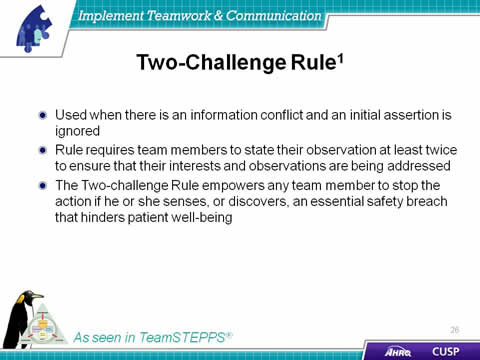
- Used when there is an information conflict and an initial assertion is ignored.
- Rule requires team members to state their observation at least twice to ensure that their interests and observations are being addressed.
- The Two-challenge Rule empowers any team member to stop the action if he or she senses, or discovers, an essential safety breach that hinders patient well-being.
Slide 27. DESC Script1
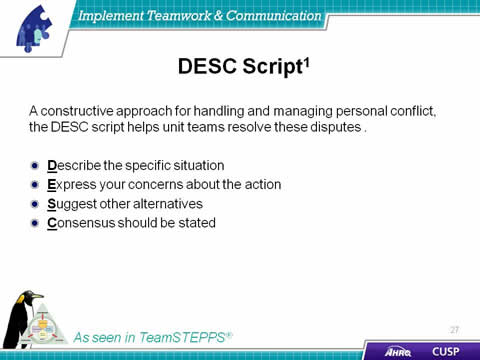
A constructive approach for handling and managing personal conflict, the DESC script helps unit teams resolve these disputes.
- Describe the specific situation.
- Express your concerns about the action.
- Suggest other alternatives.
- Consensus should be stated.
Slide 28. CUS1
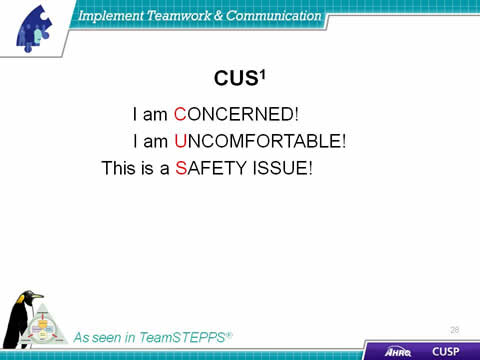
I am CONCERNED!
I am UNCOMFORTABLE!
This is a SAFETY ISSUE!
Slide 29. Collaboration1
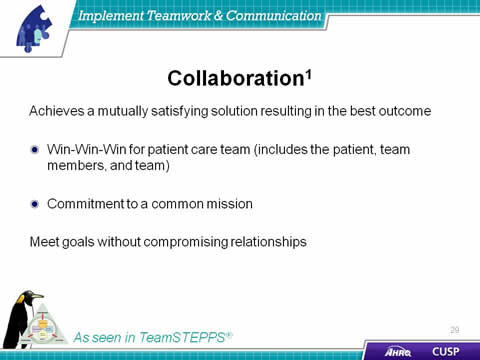
Achieves a mutually satisfying solution resulting in the best outcome.
- Win-Win-Win for patient care team(includes the patient, team members, and team).
- Commitment to a common mission.
Meet goals without compromising relationships.
Slide 30. SBAR1
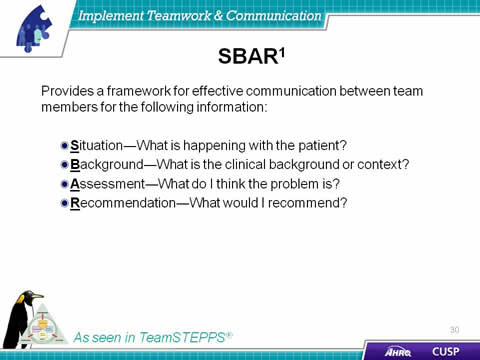
Provides a framework for effective communication between team members for the following information:
- Situation―What is happening with the patient?
- Background―What is the clinical background or context?
- Assessment―What do I think the problem is?
- Recommendation―What would I recommend?
Slide 31. Call-Out1
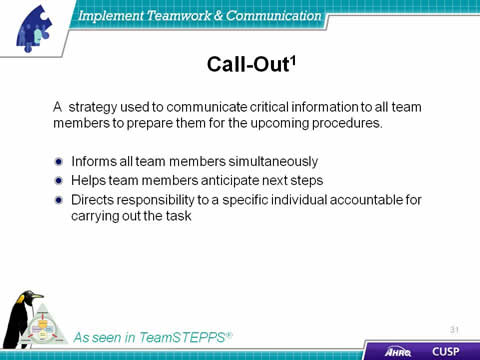
A strategy used to communicate critical information to all team members to prepare them for the upcoming procedures.
- Informs all team members simultaneously.
- Helps team members anticipate next steps.
- Directs responsibility to a specific individual accountable for carrying out the task.
Slide 32. Check-Back1
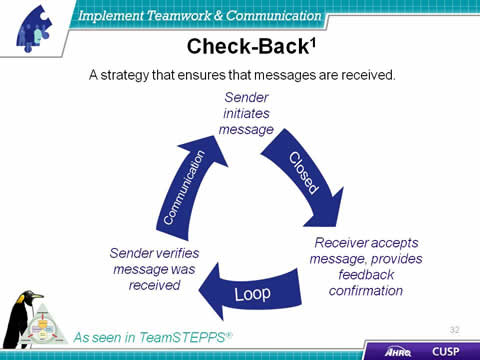
A strategy that ensures messages are received.
- Sender initiates message.
- Receive accepts message, provides feedback confirmation.
- Sender verifies message was received.
- These three steps are sections of a closed loop communication.
Slide 33. Handoff1
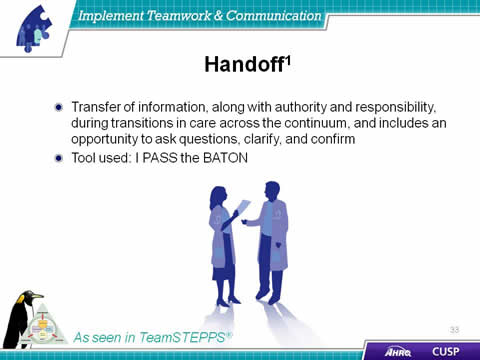
- Transfer of information, along with authority and responsibility, during transitions in care across the continuum, and includes an opportunity to ask questions, clarify, and confirm.
- Tool used: I PASS the BATON.
Slide 34. I PASS the BATON1
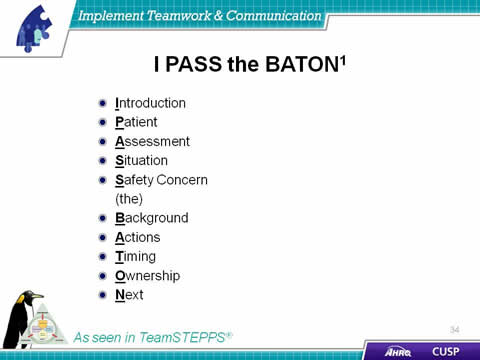
- Introduction
- Patient
- Assessment
- Situation
- Safety Concern
(the) - Background
- Actions
- Timing
- Ownership
- Next
Slide 35. Situational Awareness1
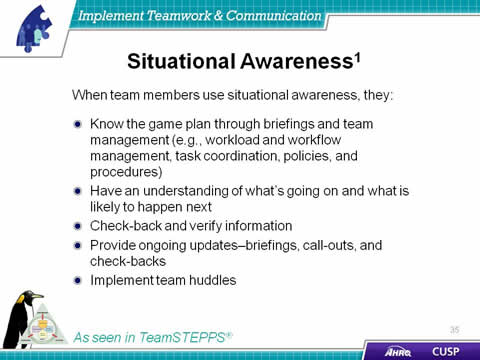
When team members use situational awareness, they:
- Know the game plan through briefings and team management (e.g., workload and workflow management, task coordination, policies, and procedures).
- Have an understanding of what’s going on and what is likely to happen next.
- Check-back and verify information.
- Provide ongoing updates—briefings, call-outs, and check-backs.
- Implement team huddles.
Slide 36. Implement Teamwork and Communication: What the Team Needs to Do
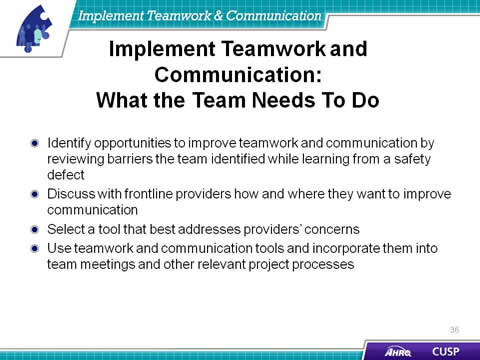
- Identify opportunities to improve teamwork and communication by reviewing barriers the team identified while learning from a safety defect.
- Discuss with frontline providers how and where they want to improve communication.
- Select a tool that best addresses providers’ concerns.
- Use teamwork and communication tools and incorporate them into team meetings and other relevant project processes.
Slide 37. Summary
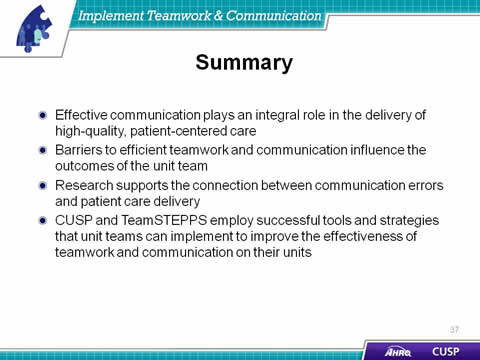
- Effective communication plays an integral role in the delivery of high-quality, patient-centered care.
- Barriers to efficient teamwork and communication influence the outcomes of the unit team.
- Research supports the connection between communication errors and patient care delivery.
- CUSP and TeamSTEPPS employ successful tools and strategies that unit teams can implement to improve the effectiveness of teamwork and communication on their units.
Slide 38. Additional CUSP Tools
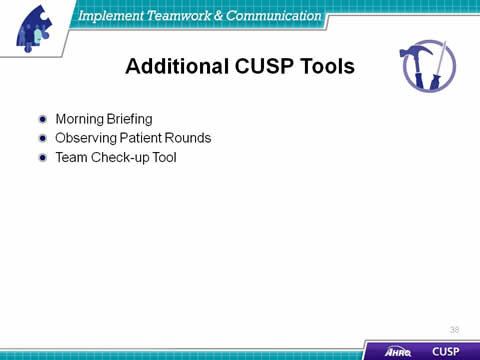
Slide 38 Image
- Morning Briefing.
- Observing Patient Rounds.
- Team Check-up Tool.
Slide 39. References
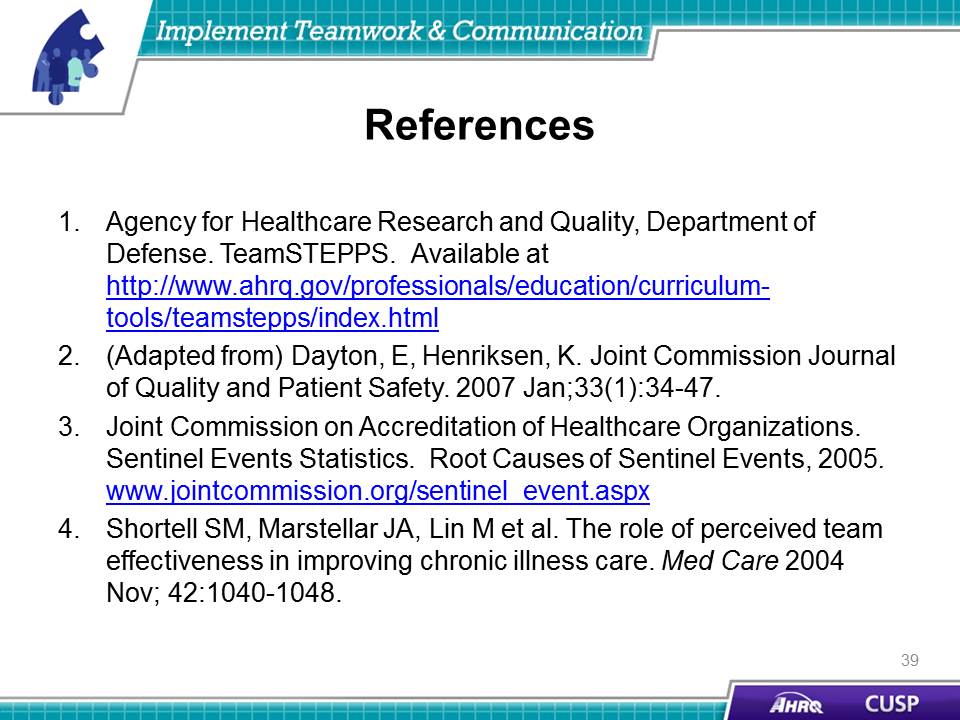
- Agency for Healthcare Research and Quality, Department of Defense. TeamSTEPPS. www.ahrq.gov/teamsteppstools/instructor/index.html
- (Adapted from) Dayton, E, Henriksen, K. Joint Commission Journal of Quality and Patient Safety. 2007 Jan;33(1):34–47.
- Joint Commission on Accreditation of Healthcare Organizations. Sentinel Events Statistics. Root Causes of Sentinel Events, 2005. http://www.jointcommission.org/sentinel_event.aspx
- Shortell SM, Marstellar JA, Lin M et al. The role of perceived team effectiveness in improving chronic illness care. Med Care 2004 Nov; 42:1040–1048.




